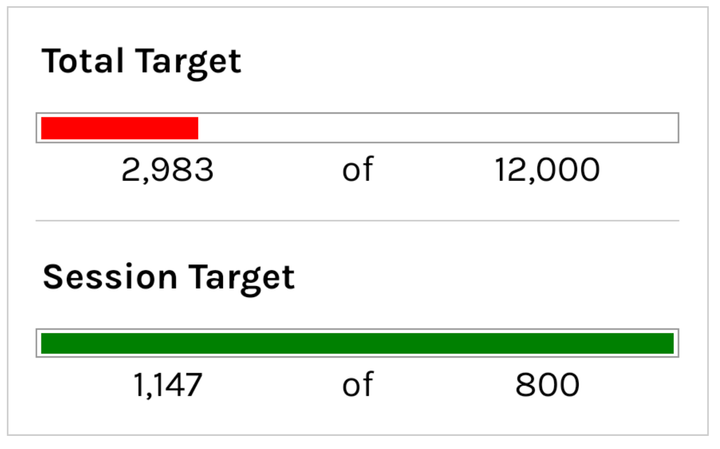20 Google Sheet Tips for Business Analysts
Learning Google Sheets empowers Business Analysts to efficiently analyze data, create insightful visualizations, collaborate with stakeholders, and streamline their data analysis workflows. It's a valuable tool for data-driven decision-making and problem-solving in a business context.

Learning Google Sheets empowers Business Analysts to efficiently analyze data, create insightful visualizations, collaborate with stakeholders, and streamline their data analysis workflows. Its cost-effectiveness, accessibility, and integration capabilities make it a valuable tool for data-driven decision-making and problem-solving in a business context.
Quickly and Effectively Analyze Financial Reports and Detect Trends
You could use this Google Sheets tutorial to quickly and effectively analyze financial reports and detect trends.
The Running Sum feature allows you to quickly identify the highest and lowest earners by simply calculating the 80/20 rule with just a few clicks.
Not only can this be done quickly, it can also be done with a user-defined dollar sign.
This gives you a more comprehensive understanding of higher and lower performing clients, which ultimately informs better decision making.
This tutorial could help you determine if the company is spending sufficient resources on high-value activities while reallocating funds from the low-value ones.
Identify Trends and Underlying Patterns More Efficiently
You can use this Google Sheets tutorial by Better Sheets to help you hone your skills in counting various data sets when analyzing company data.
The tutorial provides tips on how to use COUNTIF(), COUNTIFS(), and COUNTBLANK() functions to help simplify the counting process.
This is especially valuable if you create reports that need to incorporate aggregated, related data, such as analyzing marketing and sales results.
Knowledgeable use of the COUNTIF and COUNTIFS functions will help you more efficiently identify trends and underlying patterns and get a more efficient, detailed view of the company's performances.
Get More Productive When Working with International Data
You could use this video tutorial to better understand how region settings can affect the data in Google Sheets.
This knowledge is especially important because you will often have to work with data from multiple countries, and would need to be aware of how this data is presented in Google Sheets.
The video describes how setting the locale could affect number formatting, date ordering, and currency, which might be needed knowledge when working with international data.
As such, the tutorial presents a great opportunity for you to gain the necessary skills to better handle Google Sheets and be more productive when working with international data.
Automate More Complex Processes
You could use the topics covered in this tutorial to get better at writing app scripts for your regularly used spreadsheets.
It could enable you to automate more complex processes which are common in the business analyst role, such as generating reports from multiple sheets or combining data from a large dataset.
You can then refine the scripts and functions you have written and use them to build better solutions in the future.
In addition, you can use Google Sheet for data visualization and creating customized dashboards to in order to assess trends of company performance over time.
Be More Efficient and Save Time in Your Job
You could use this tutorial by Better Sheets to become more efficient and save time in their job.
You could take the skills they learn in the video, such as hiding and unhiding columns, changing column widths, and using autofit column width, and apply them to their workflow in Google Sheets.
For example, a common use case for you may be to replicate report data in Google Sheets with various formatting applied.
Using the skills gained in this video tutorial, you will be better equipped to quickly update the formatting applied to the data in order to present it clearly.
Save Time and Improve the Accuracy of Your Results
You can use the tutorial on Google Sheets from Better Sheets to efficiently filter through data.
By utilizing checkboxes, dates, or dropdown selections, you can quickly find the necessary data needed for their research.
This data can be used to measure important trends or calculate metrics for evaluation.
By using this video tutorial to hone their skills, you can save time and improve the accuracy of your results as you learn how to better use Google Sheets to filter through data to meet their needs.
Gain the Skills to Solve Many of the Common Use Cases
You could use this Google Sheets tutorial by Better Sheets to gain the skills to solve many of the common use cases you encounter while doing your job.
Specifically, the tutorial can help you efficiently extract URLs from Google Sheets into different columns or text strings, which can be used for data scraping, web search analysis, or content management.
Furthermore, you can learn how to apply a formula to separate and organize the URLs and filter their results with the IF function.
This would be invaluable to you when doing data-driven analysis and reporting.
Learn this to Help You in Explaining the Deeper Meaning of Data and Trends
You could use the Google Sheets tutorial from Better Sheets to better organize data and create visuals that communicate trends and relationships in the datasets.
By using the ability to hide gridlines and create different colors and fonts, this would enable you to create visualizations that capture the most relevant facts or figures quickly, while maintaining a clean and presentable look.
This could help you explain to stakeholders the deeper meaning of data and trends that will influence decisions or reforms.
The skills learned from this tutorial would help you better represent their data in a comprehensive and professional way.
Quickly and Accurately Compare Data from Multiple Sources
You could use the Google Sheets tutorial by Better Sheets to learn a variety of ways to help streamline your work in Google Sheets.
With the four ways demonstrated in the video, you can quickly and easily make multiple separate sheets from the same document, read data from separate sheets more quickly, create multiple spreadsheets with related data in the same workbook, and create a base template that can be reused time and again.
These skills are especially useful for data analysis purposes, where you need to be able to quickly and accurately compare data from multiple sources and in various formats for an in-depth analysis.
Save Time and Improve the Quality of Your Analysis
You could use this tutorial by Better Sheets to quickly ramp-up your familiarity with Google Sheets.
The tutorial starts from the basics - covering basic text functions - and builds up to Apps Script, teaching progressively more advanced features in-between.
This is ideal for you as a business analyst who has to analyze data for a report, as you could use this tutorial to quickly get a better understanding of different functions needed, such as using formulas and scripting automation loops.
This could save you time and improve the quality of your analysis. Also, the tutorial explains the different levels of complexity for each topic - meaning you could quickly identify tasks that require the most effort.
This makes it easier for you to prioritize tasks correctly when relying on your own knowledge of the platform.
Get Better at Dealing with Large Volumes of Data
You could use the Combine 2 Column Into One Column tutorial by Better Sheets to combine first and last names into one column.
This could be useful when creating lists of contacts or customer accounts by merging pieces of data from other columns of information.
Additionally, the tutorial provides visual instructions for how to use the CONCATENATE formula, which is a powerful tool in the context of data consolidation or data transformation.
From there, you can use the MERGE option to automate the process even further.
This could be extremely helpful when dealing with large volumes of data.
Quickly and Accurately Analyze Data Sets
You could use this tutorial to learn how to use powerful but potentially complex COUNTIF and COUNTIFS formulas in Google Sheets.
This knowledge would allow you to quickly and accurately analyze data sets and leverage those insights to inform your decision making.
Through the video tutorial, you can gain comfort with the deeper aspects of Google Sheets and learn best practices for how to use the functions to get the most accurate answers within the shortest time frame.
As business analysts, you are often required to make quick decisions based on a deep interpretation of complex data sets, a solid understanding of the COUNTIF and COUNTIFS formulas will make the process faster and easier.
Quickly Discover Insights from Data
You could use this tutorial from Better Sheets to become more comfortable with manipulating datasets using formulas.
For example, the tutorial explains how to quickly pull related data from a table of data, such as with AI formulas like ARRAYFORMULA, QUERY, and VLOOKUP.
This could help you more quickly analyze data to discover patterns and relationships for data-driven decision making.
In addition, the use of dynamic arrays like SORT, UNIQUE, FILTER, and DATE can be used to effectively sort, filter, and filter out unique data from large and complex datasets.
This could be beneficial for you to quickly discover insights from data which might be beneficial to their organization.
Produce Well-designed, Informative Dashboards
You could use this particular tutorial by Better Sheets on Youtube to learn how to use Merge Cells to produce professional dashboards.
This could be especially beneficial when it comes to constructing summarized reports as the Merge Cell functionality could help to reduce wasted space on a report, while simultaneously creating a more visually appealing dashboard.
Additionally, this tool could help you to capture and present significant insight from datasets, enabling them to identify key trends and make high-level decisions quickly and efficiently.
Ultimately, this tutorial could help you to use Google Sheets more effectively and take full advantage of Merge Cells’ capabilities to produce well-designed, informative dashboards.
Make It Easier to Accurately Track and Manage A Complex Project
You could use this Google Sheet tutorial to become more proficient at data analysis, forecasting, and planning.
With the skills gained from this tutorial, you can more effectively interpret data in a visual manner and create useful charts and spreadsheets to better inform your decision making.
This tutorial could also be used to create detailed budgets and project plans, which you would use to assess any financial projections or plan any upcoming projects.
Additionally, the tutorial will guide the business analyst through creating a working PR agency in a Google Sheet template making it easier to accurately track and manage a complex project and analyze the associated data.
Assess Large Amounts of Data Quickly and Accurately
You could use the video tutorial by Better Sheets to learn how to submit claimed stores to the virtual mall using Google Sheets to make store information updates more efficient.
The tutorial will teach how to create and populate data fields, perform lookup functions, and format the submission in the appropriate layout.
The skills learned in the tutorial can then be applied to other use cases that you may encounter at work, such as being able to assess large amounts of data quickly and accurately, present the data in an easy-to-read format, and collaborate efficiently with colleagues.
This can ultimately save time and effort, and allows the business analyst to become more productive and successful.
Learn Shortcuts and Tricks for Organizing Data
You could use this video tutorial to become more efficient at working with Google Sheets for various tasks.
You could use it to learn shortcuts and tricks for organizing data, or quickly summarizing data in their workflows.
With the skills obtained from this tutorial, you could more quickly format tables, create charts, and use data validation tools for data entry.
You could also use Google Sheets for automating and quickly replicating various calculations and formulas, which provides valuable insight to the decisions made by the business.
Quickly Capture Users’ Preferences and Run Trend Analysis
You can use this Google Sheets tutorial to create dynamic LinkTree within your sheet which will enable you to store an unlimited amount of content and organize it based on a user’s needs.
This would allow you to quickly and easily access items and link them. You could then use this ability to organize data within a project, link to other documents, or access data points quickly for data analysis projects.
This would help speed up your workflow and increase the efficiency of your job. Furthermore, you could also use this tutorial to develop powerful landing pages within your spreadsheet and capture key data points without needing to code.
This would be particularly useful in scenarios where you want to quickly capture users’ preferences and run trend analysis.
Improve Accuracy of Your Data Analysis and Findings
You could use the Google Sheet tutorial by Better Sheets to become better acquainted with Google Sheets features and functions.
By honing in on and mastering the "one Google Sheets trick to count blank rows and blank cells," you would be able to quickly quantify data from within their spreadsheets.
As a result, this would help improve accuracy of your data analysis and findings, and your ability to make strategic decisions and recommendations.
Becoming better at using Google Sheets will also help you to be better at your job in general, as Google Sheets is an important tool used in business analysis.
Enhance Your Data Analysis Skills and Increase Efficiency in Your Job
You could use this Google Sheet tutorial by Better Sheets to enhance your data analysis skills and increase efficiency in your job.
Through the video tutorial, you can learn new techniques such as using filters, pivot tables, data validation rules and importing data from other sources to quickly and effectively summarize data and identify key insights.
More specifically, you could use the filter and pivot table techniques to sort large datasets by columns, creating a summary page for report purposes.
The data validation rules could also be used to simplify the process of error-checking and improve the accuracy of their observation.
The ability to import data from other sources also allows you to combine and compare data from various sources, which could give you a better overall understanding of the data.
Learn More
I have created over 40 tutorials on Data Analysis in Google Sheets on Better Sheets.
Check it out: https://bettersheets.co/topics/data-analysis



